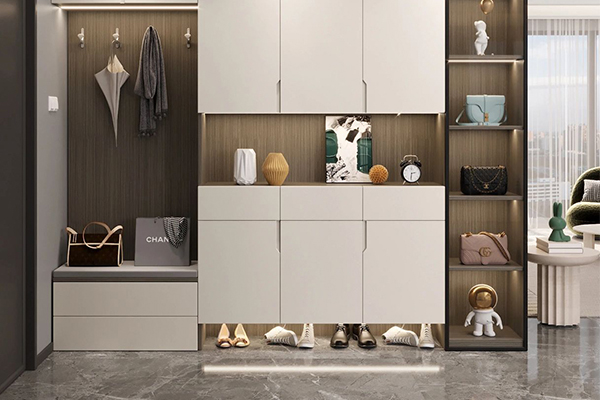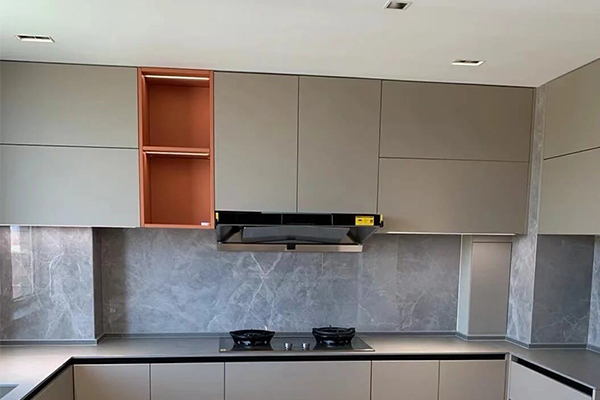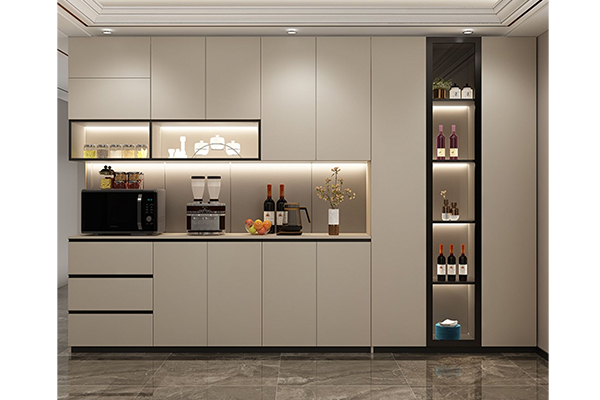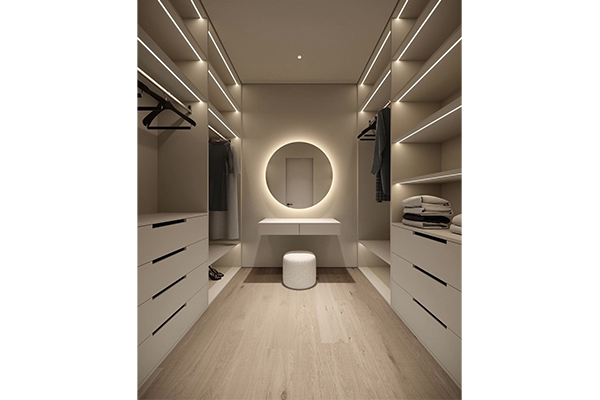What is the structural stability of solid wood particle board shoe cabinets? How to reduce the deformation of cabinets during long-term use?
Release Time : 2025-09-01
Solid wood particleboard shoe cabinets, a common storage fixture in entryways, are prone to deformation over time due to load, humidity fluctuations, or loose structures. Structural stability design is crucial for preventing these issues at their root. Deformation in solid wood particleboard shoe cabinets often manifests as cabinet tilting, sagging shelves, and awkward door openings, which not only impacts aesthetics but also reduces usability. Structural stability is achieved through the coordinated efforts of various factors, including substrate properties, frame design, and connection techniques, providing continuous support and restraint for the cabinet, mitigating the risk of deformation over time.
The substrate properties of solid wood particleboard shoe cabinets are the foundation of their structural stability, providing resistance to deformation at the material level. Solid wood particleboard is made from wood particles pressed under high temperature and high pressure, resulting in a uniform particle distribution and a dense internal structure. Compared to ordinary fiberboard or solid wood panels, its transverse and longitudinal mechanical properties are more balanced, making it less susceptible to unidirectional bending due to uneven loads. When a solid particleboard shoe cabinet carries multiple pairs of shoes (especially heavy leather shoes and boots), the uniform grain structure distributes the weight across the entire surface, preventing localized pressure from causing dents in the shelves or bending in the side panels, and providing material support to maintain the cabinet's long-term flatness.
The frame-like design of a solid particleboard shoe cabinet further enhances overall stability and reduces cabinet warping and deformation. High-quality solid particleboard shoe cabinets utilize a "sides - top - bottom - back" frame structure. The side panels, as the primary load-bearing components, are constructed from thicker solid particleboard (typically at least 18mm) to ensure vertical support. The top and bottom panels are tightly connected to the side panels using three-in-one connectors and dowels, forming a stable rectangular frame. This structure resists lateral forces (such as collisions and the pull of cabinet doors), preventing the cabinet from tilting over time. Some solid wood particleboard shoe cabinets also incorporate internal transverse support bars connecting the side panels to further distribute lateral stress and reduce outward deformation of the side panels caused by unilateral loads.
The support structure of the shelves is key to reducing shelf sag and deformation in solid wood particleboard shoe cabinets. Shelves are the core storage components of solid wood particleboard shoe cabinets, and prolonged loads of shoes can lead to sagging in the middle. To address this, solid wood particleboard shoe cabinets incorporate support bars or metal brackets beneath the shelves. These support bars, typically made of solid wood or thick solid wood particleboard, are fixed along the length of the shelves between the side panels, directly supporting the center of the shelves. The metal brackets are screwed to the bottom of the shelves, providing multi-point support. These support structures distribute the load of the shelves across multiple points, preventing the shelves from gradually bending in the middle due to gravity when connected only to the side panels at their ends. This ensures that the shelves remain level even after extended use.
The back panel connection technique of a solid wood particleboard shoe cabinet plays a crucial role in maintaining the cabinet's integrity and reducing lateral bending. Although the back panel doesn't directly bear weight, it forms a "box-like" constraint with the frame structure, preventing lateral bending caused by uneven loads on both sides. The back panel of a solid wood particleboard shoe cabinet is often made of thin solid wood particleboard (such as 5mm or 9mm), secured to the inside of the frame using both glue and nails, forming a tight fit with the side panels, top, and bottom. This connection method allows the back panel to provide lateral tension to the frame. When the cabinet is subjected to unilateral external forces (such as slight pressure from the wall when placed against it, or the impact of daily shoes when being removed), the back panel balances the stress on both sides, preventing the side panels from bending outward and maintaining the cabinet's rectangular shape.
The edge banding and moisture-proofing of solid wood particleboard shoe cabinets also indirectly enhance structural stability and reduce deformation caused by environmental factors. The entryway is susceptible to external moisture (such as rainwater and residual moisture from shoes). If solid particleboard absorbs moisture and expands, it can cause the cabinet's dimensions to change and cause deformation. Solid particleboard shoe cabinets typically use PVC edge banding or hot-melt adhesive to seal the edges. This seal is achieved through high temperature and pressure, preventing moisture from seeping into the panel. Some cabinets also apply a moisture-proof coating on the side of the back panel that contacts the wall to further isolate moisture. This moisture-proof treatment ensures that the solid particleboard maintains stable dimensions over time, preventing deformation caused by moisture absorption and expansion, such as cabinet bulging and door jamming.
The quality of the hardware fasteners in solid particleboard shoe cabinets is crucial to maintaining long-term structural stability and reducing deformation caused by loose connections. The cabinet frame, doors, and cabinet body are connected by hardware (such as three-in-one connectors, hinges, and hinges). High-quality hardware offers high strength and wear resistance, ensuring long-term securement. For example, the screw and nut of the three-in-one connector are made of metal, with a tight thread engagement that securely connects the side panels to the top/bottom panels, preventing loosening due to vibration or temperature fluctuations over time. The hinges are secured with multiple sets of screws, ensuring a stable connection between the door and the cabinet body, reducing deformation of the cabinet front caused by door sagging. The stable connection of these hardware components provides continuous restraint to the overall structure of the solid wood particleboard shoe cabinet, preventing cascading deformation caused by loose local connections.
From a user's perspective, the structural stability of the solid wood particleboard shoe cabinet not only reduces maintenance headaches caused by deformation but also extends the cabinet's lifespan. Without frequent adjustments to the cabinet body or replacement of shelves, the cabinet doors open and close smoothly, and the storage space remains flat. This ensures that the solid wood particleboard shoe cabinet maintains its excellent appearance and functionality over time, providing reliable storage for entryways. This design, which prioritizes structural stability, also demonstrates the practicality and durability of solid wood particleboard shoe cabinets, meeting the needs of long-term family use.







